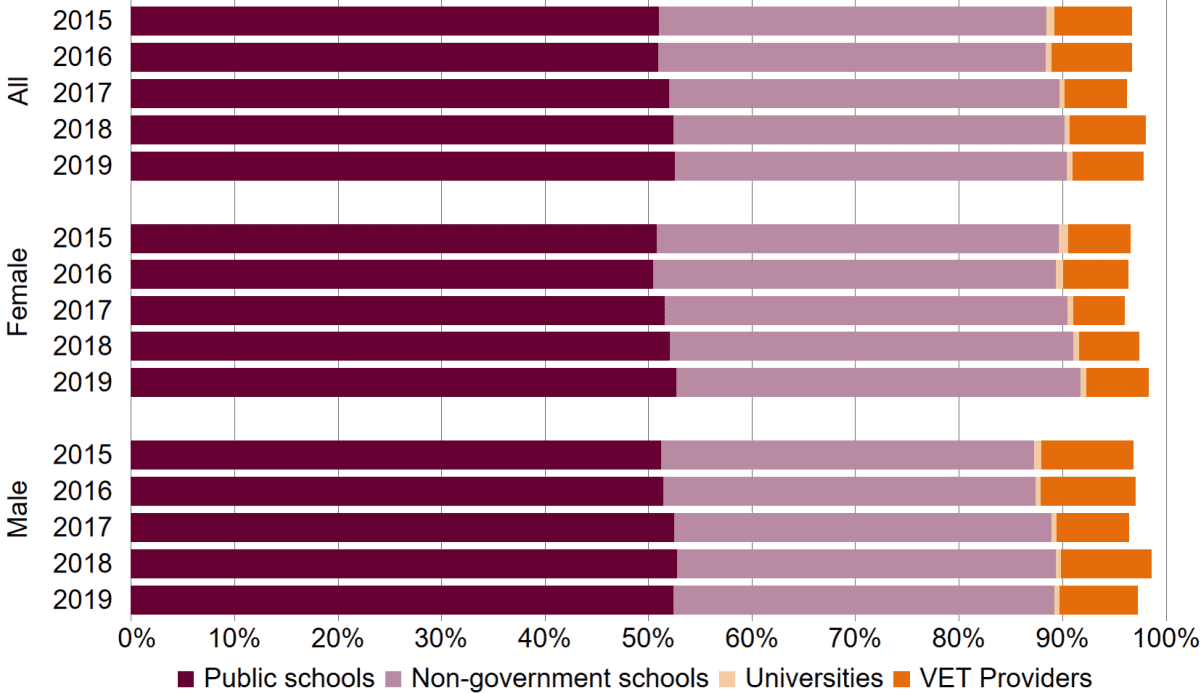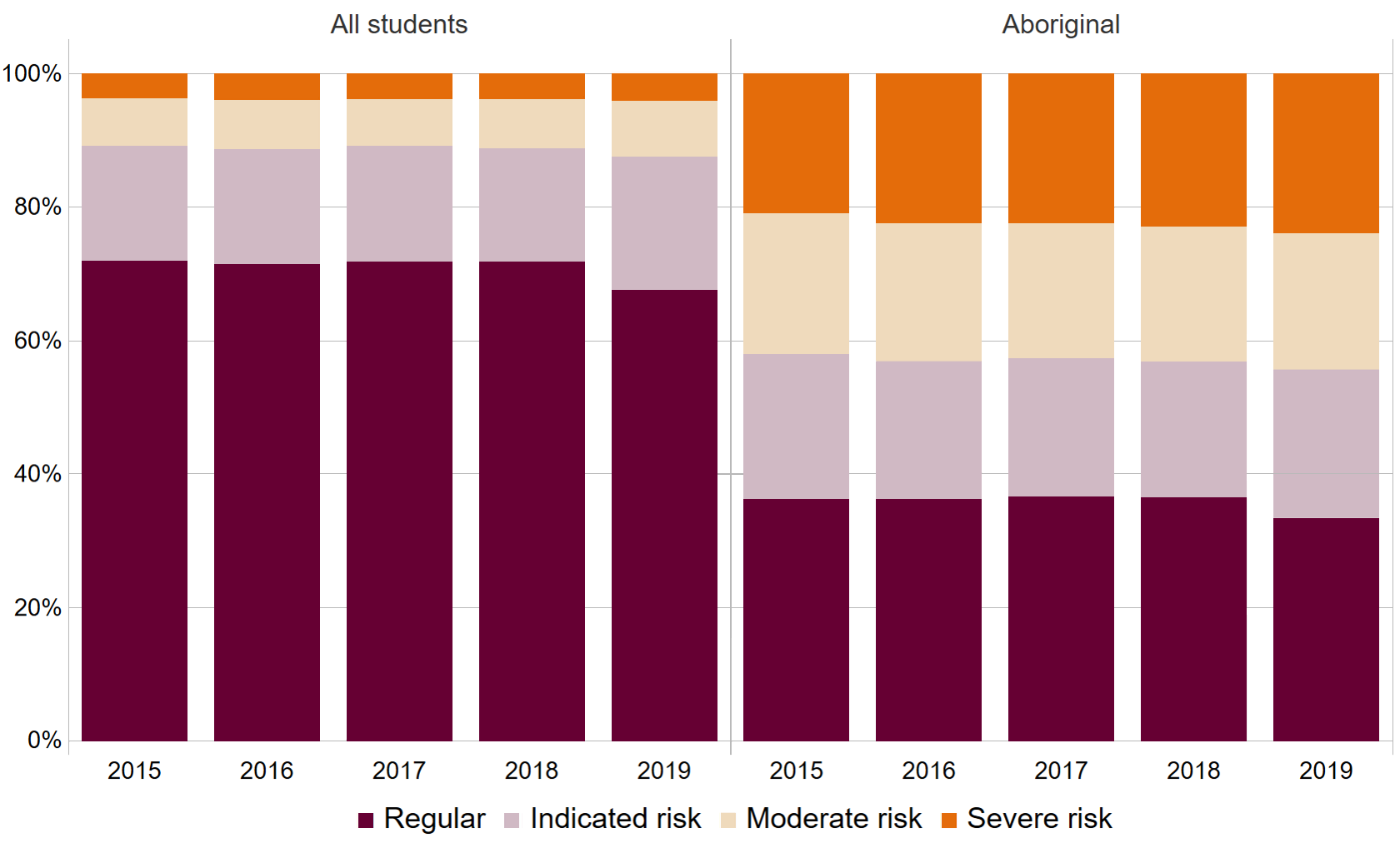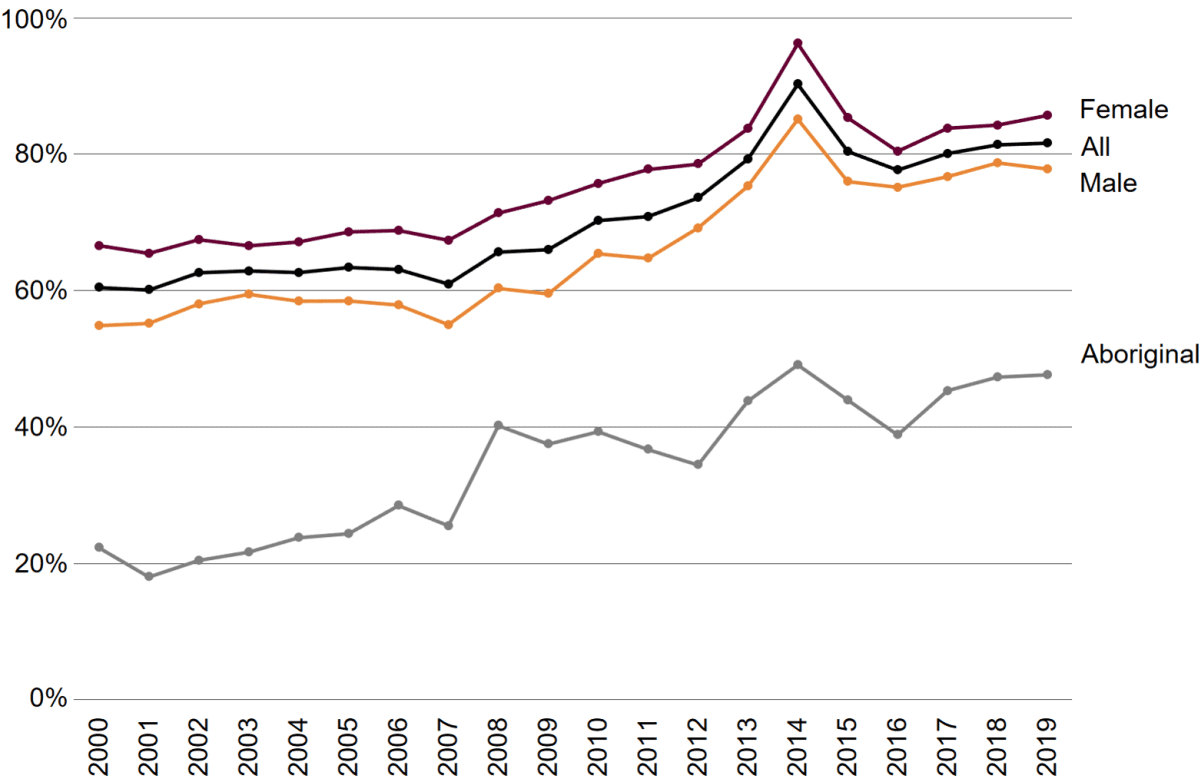3. Student participation, achievement and satisfaction
Appendix 3
- Contents
- Figure A6: Participation rate (%) of persons aged 15 to 17 years engaged in some form of education by gender 2015 to 2019
- Table A17: Public school student attendance rate (%) by level of education and subgroup 2019
- Table A18: Percentage of public school students by attendance category by subgroup 2019
- Figure A7: Percentage of public school students by subgroup by attendance category 2015 to 2019
- Table A19: Apparent retention rate (%) of public school students Years 8 to 12 by subgroup 2015 to 2019
- Figure A8: Apparent retention rate (%) of public school students Years 8 to 12 by subgroup 2000 to 2019
- Table A20: Year 12 public school student WACE achievement rate and attainment rate by subgroup 2018 and 2019
- Table A21: Year 12 public school student ATAR achievement by subgroup 2018 and 2019
- Table A22: Year 12 public student VET certificate II or higher achievement by subgroup 2018 and 2019
- Table A23: WACE achievement rate (%) of Year 12 public school students by subgroup 2015 to 2019
- Table A24: Satisfaction of Year 12 public school students by subgroup 2015 to 2019
‘Primary’ denotes Kindergarten to Year 6 and ‘Secondary’ spans Years 7 to 12 unless specified otherwise.
Figure A6: Participation rate (%) of persons aged 15 to 17 years engaged in some form of education by gender 2015 to 2019(a)(b)(c)

(a) Based on Australian Bureau of Statistics preliminary estimates of resident population (age at 30 June) and data collected from public and non-government schools (Semester 2 student census, age at 1 July), universities (age at 30 June), and vocational education and training providers (age at 30 June).
(b) University enrolment data for 2019 is an estimate based on 2018 university enrolment data and an annual compound growth factor calculated from university enrolment data across the previous four years.
(c) Revised figures for 2018 due to updated data for 2018 university student enrolments and estimate of resident population.
Table A17: Public school student attendance rate (%) by level of education and subgroup 2019(a)(b)
| Level of education | Aboriginal | Non-Aboriginal | All |
|---|---|---|---|
| All | 74.3 | 91.2 | 89.8 |
| Primary(c) | 79.5 | 92.7 | 91.6 |
| Secondary | 65.8 | 88.8 | 86.8 |
(a) Excludes Kindergarten students, Canning College students, part-time and international students, and mature-aged students at senior campuses.
(b) As per National Standards for Student Attendance Data Reporting.
(c) Pre-primary to Year 6.
Table A18: Percentage of public school students by attendance category by subgroup 2019(a)(b)(c)
| Attendance category | Aboriginal | Non-Aboriginal | All | ||||||||
|---|---|---|---|---|---|---|---|---|---|---|---|
| Regular attendance (90–100%) | 33.3 | 71.0 | 67.7 | ||||||||
| Indicated attendance risk (80–<90%) | 22.3 | 19.8 | 20.0 | ||||||||
| Moderate attendance risk (60–<80%) | 20.5 | 7.0 | 8.2 | ||||||||
| Severe attendance risk (<60%) | 23.9 | 2.2 | 4.2 |
(a) Excludes Kindergarten students, Canning College students, part-time and international students, and mature‑aged students at senior campuses.
(b) Percentages may not add to 100% due to rounding.
(c) As per National Standards for Student Attendance Data Reporting.
Figure A7: Percentage of public school students by subgroup by attendance category 2015 to 2019(a)(b)

(a) Excludes Kindergarten students, Canning College and Tuart College students, part-time and international students, and mature‑aged students at senior campuses.
(b) As per National Standards for Student Attendance Data Reporting.
Table A19: Apparent retention rate (%) of public school students Years 8 to 12 by subgroup 2015 to 2019(a)(b)
| Subgroup | 2015 | 2016 | 2017 | 2018 | 2019 | |||||
|---|---|---|---|---|---|---|---|---|---|---|
| % | N | % | N | % | N | % | N | % | N | |
| All | 80.4 | 13,005 | 77.7 | 13,398 | 80.1 | 13,856 | 81.4 | 13,925 | 81.6 | 14,041 |
| Female | 85.3 | 6,531 | 80.4 | 6,612 | 83.8 | 6,927 | 84.3 | 6,874 | 85.7 | 7,118 |
| Male | 76.0 | 6,474 | 75.1 | 6,786 | 76.7 | 6,929 | 78.7 | 7,051 | 77.8 | 6,923 |
| Aboriginal | 43.9 | 645 | 38.8 | 627 | 45.3 | 717 | 47.3 | 718 | 47.6 | 768 |
| Female | 46.2 | 306 | 38.0 | 285 | 46.7 | 356 | 47.3 | 355 | 48.4 | 397 |
| Male | 42.1 | 339 | 39.5 | 342 | 44.1 | 361 | 47.3 | 363 | 46.8 | 371 |
(a) Excludes Canning College and Tuart College students, part-time and international students, and mature-aged students at senior campuses.
(b) ‘N’ is the number of Year 12 students. All data as at Semester 2 student census.
Figure A8: Apparent retention rate (%) of public school students Years 8 to 12 by subgroup 2000 to 2019(a)(b)

(a) Excludes Canning College and Tuart College students, part-time and international students, and mature-aged students at senior campuses.
(b) Semester 2 student census.
Table A20: Year 12 public school student WACE achievement rate and attainment rate by subgroup 2018 and 2019(a)
| Subgroup | 2018(b) | 2019 | ||||
|---|---|---|---|---|---|---|
| % | N | % | N | |||
| WACE achievement rate(c) | All Aboriginal | 80.5 | 11,589 | 80.7 | 11,617 | |
| Attainment rate(d) | All Aboriginal | 90.9 | 13,223 | 90.9 | 13,197 | |
(a) ‘N’ is the number of students who achieved the outcome.
(b) A few registered training organisations did not complete VET certification for some public school students in time to be included in the 2018 data. This may have affected the data reported for 2018 for WACE achievement, attainment and achievement of VET certificates.
(c) Percentage of Year 12 full-time students in the Semester 2 student census who achieved WACE. See our WACE achievement key performance indicator for details on criteria required to achieve WACE.
(d) Percentage of Year 12 students who achieved an ATAR of at least 55 and/or a certificate II or higher VET qualification. The number of Year 12 students at Semester 2 student census is the denominator, a different methodology to previous years which only included full-time WACE eligible.
Table A21: Year 12 public school student ATAR achievement by subgroup 2018 and 2019(a)
| 2018 | 2019 | ||||||
|---|---|---|---|---|---|---|---|
| Subgroup | Students | Median ATAR | Students | Median ATAR | |||
| % | N | % | N | ||||
| Students who achieved an ATAR(b) | All Aboriginal | 36.8 | 5,355 | 79.5 | 34.1 | 4,950 | 78.25 |
| ATAR students who achieved at least 55 | All Aboriginal | 85.2 | 4,563 | – – | 85.2 51.8 | 4,216 29 | – – |
(a) ‘N’ is the number of students who achieved the outcome.
(b) Percentages use the number of Year 12 students at Semester 2 student census as the denominator, a different methodology to previous years which only included full-time students.
Table A22: Year 12 public student VET certificate II or higher achievement by subgroup 2018 and 2019(a)
| 2018(b) | 2019 | |||||
|---|---|---|---|---|---|---|
| Subgroup | Students | Total VET certificates II or higher | Students | Total VET certificates II or higher | ||
| %(c) | N | %(b) | N | |||
| All | 73.8 | 10,732 | 16,183 | 76.0 | 11,037 | 16,284 |
| Aboriginal | 67.4 | 489 | 716 | 68.1 | 525 | 702 |
(a) ‘N’ is the number of students who achieved a VET certificate II and higher.
(b) A few registered training organisations did not complete VET certification for some public school students in time to be included in the 2018 data. This may have affected the data reported for 2018.
(c) The number of Year 12 students at Semester 2 student census is the denominator, a different methodology to previous years which only included full-time students.
Table A23: WACE achievement rate (%) of Year 12 public school students by subgroup 2015 to 2019(a)(b)
| Subgroup | 2015 | 2016 | 2017 | 2018(c) | 2019 |
|---|---|---|---|---|---|
| All | 87.7 | 79.8 | 79.5 | 80.5 | 80.7 |
| Male | 85.2 | 78.3 | 77.2 | 77.9 | 78.1 |
| Female | 90.1 | 81.3 | 81.9 | 83.2 | 83.2 |
| Aboriginal | 60.5 | 46.9 | 44.8 | 47.7 | 46.7 |
(a) Year 12 full-time students in the Semester 2 student census.
(b) Year 12 WACE achievement data from the School Curriculum and Standards Authority and taken at a point in time. Data may be updated after this time for a variety of reasons such as students successfully appealing their results.
(c) A few registered training organisations did not complete VET certification for some public school students in time to be included in the 2018 data. This may have affected the data reported for 2018.
Table A24: Satisfaction of Year 12 public school students by subgroup 2015 to 2019(a)
| Subgroup | 2015 | 2016 | 2017 | 2018 | 2019 |
|---|---|---|---|---|---|
| % satisfied with quality of teaching | |||||
| All | 88.4 | 87.3 | 88.0 | 87.7 | 87.4 |
| Male | 87.8 | 87.0 | 87.5 | 87.1 | 86.5 |
| Female | 88.9 | 87.6 | 88.6 | 88.3 | 88.3 |
| Aboriginal | 92.3 | 91.0 | 88.2 | 89.9 | 86.5 |
| % satisfied with quality of education facilities | |||||
| All | 84.8 | 83.3 | 83.4 | 84.8 | 83.3 |
| Male | 84.2 | 83.2 | 83.2 | 84.7 | 82.5 |
| Female | 85.4 | 83.5 | 83.7 | 84.9 | 84.1 |
| Aboriginal | 88.1 | 84.6 | 82.6 | 88.2 | 83.9 |
(a) Post school intentions and satisfaction survey, conducted in Semester 2.